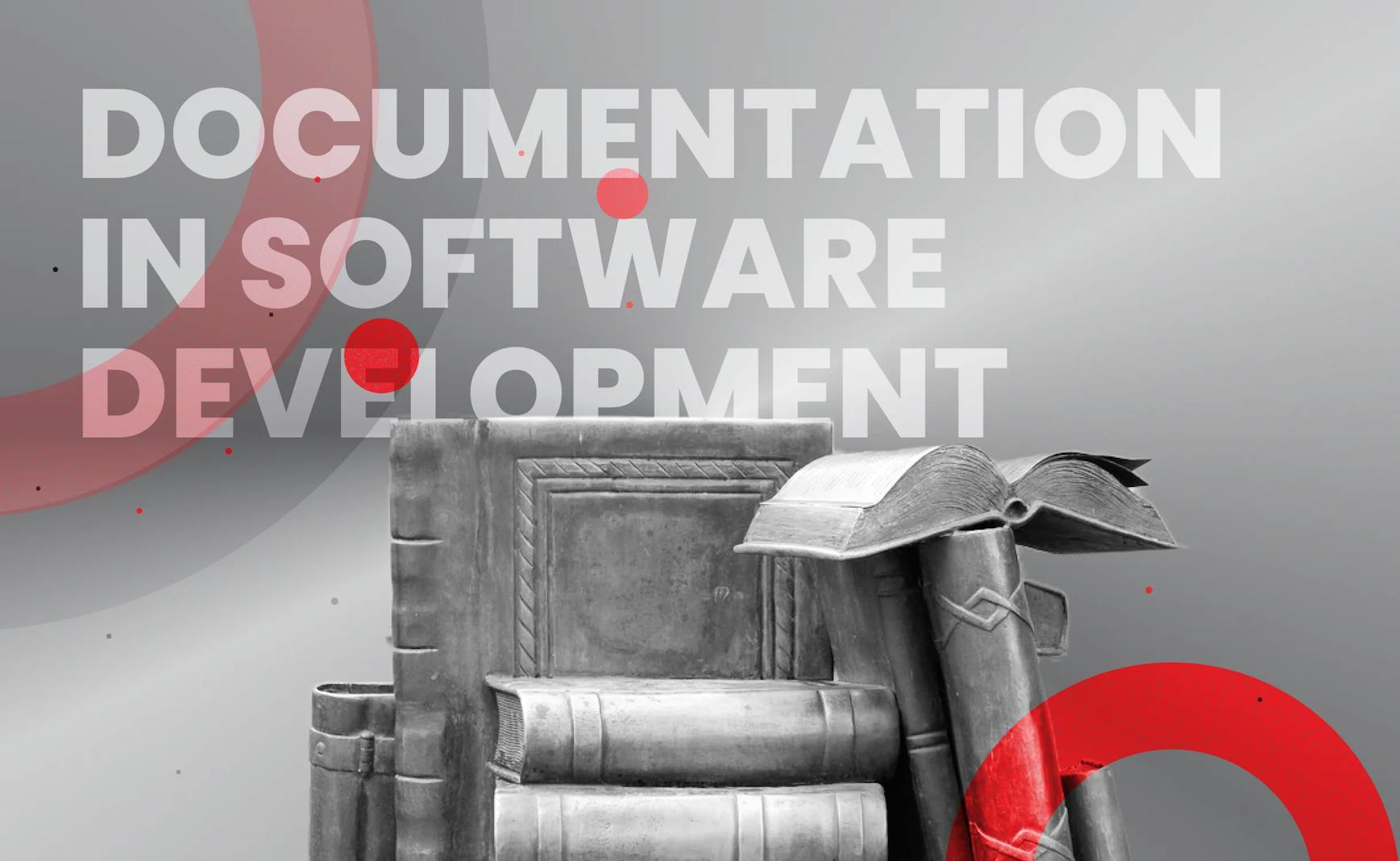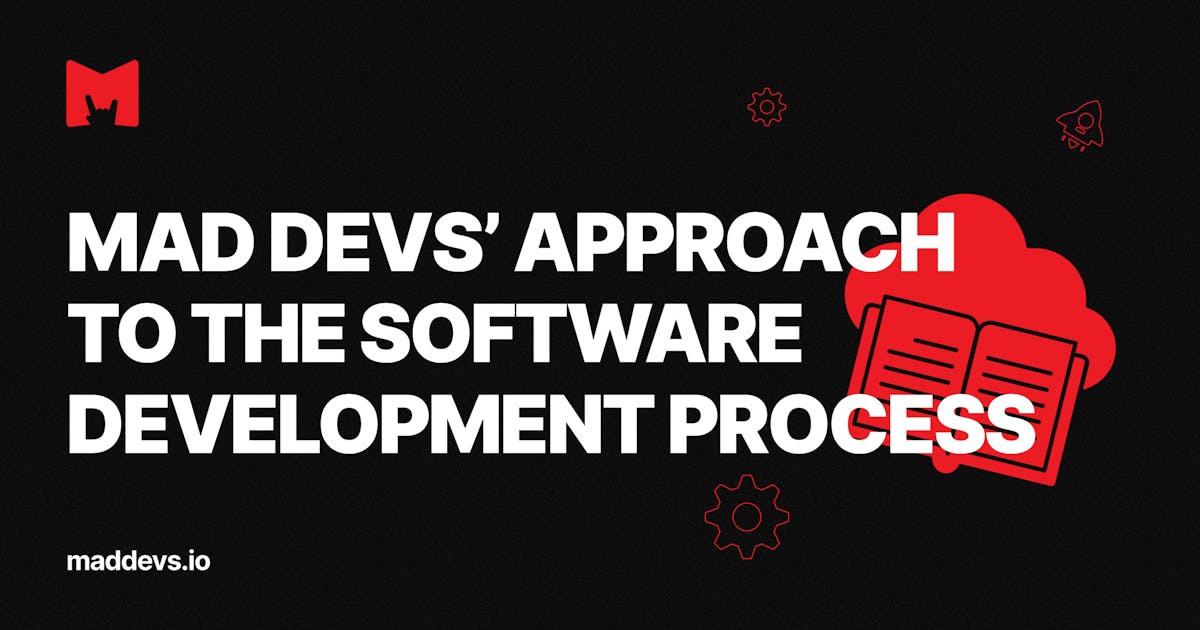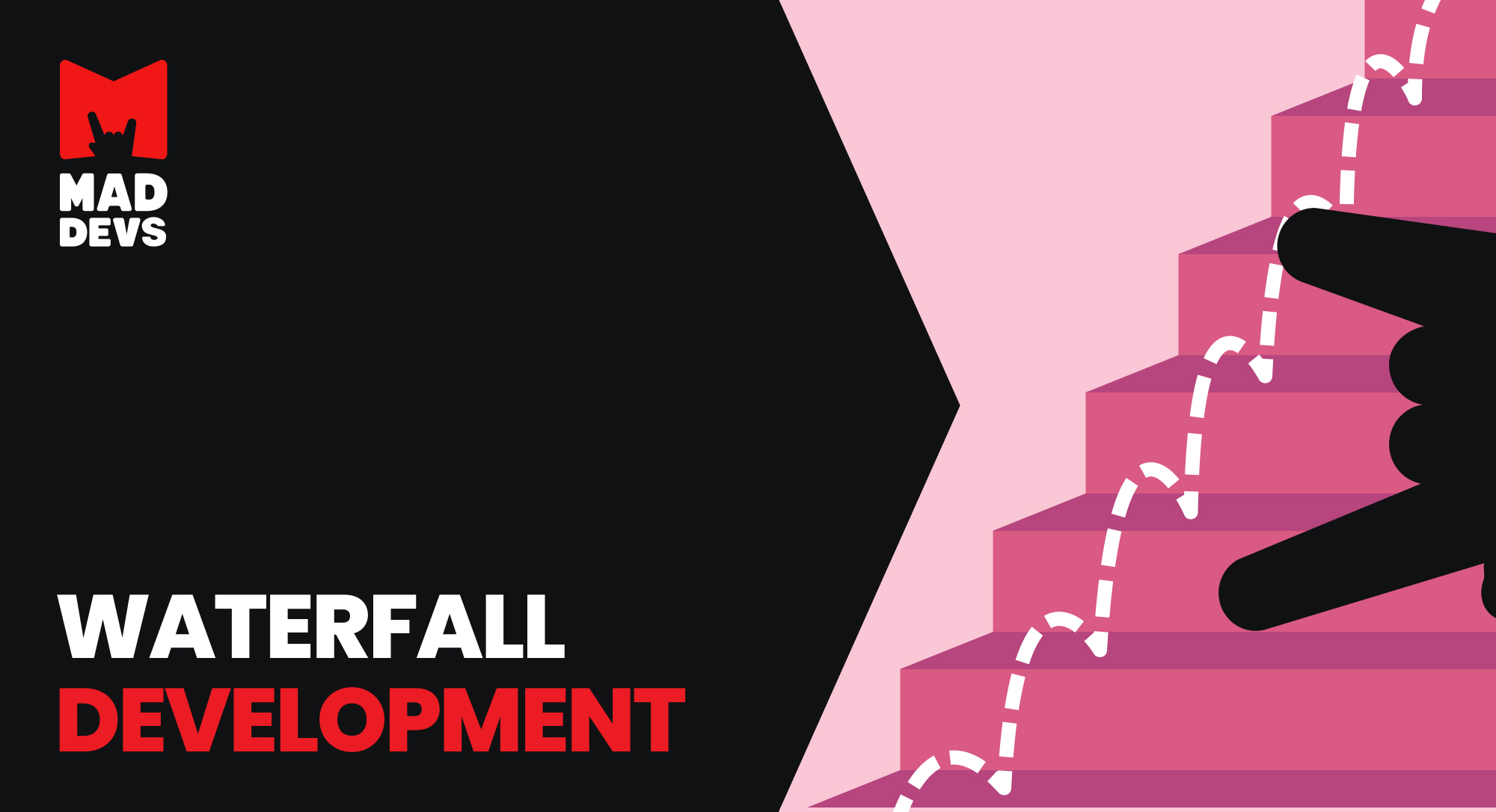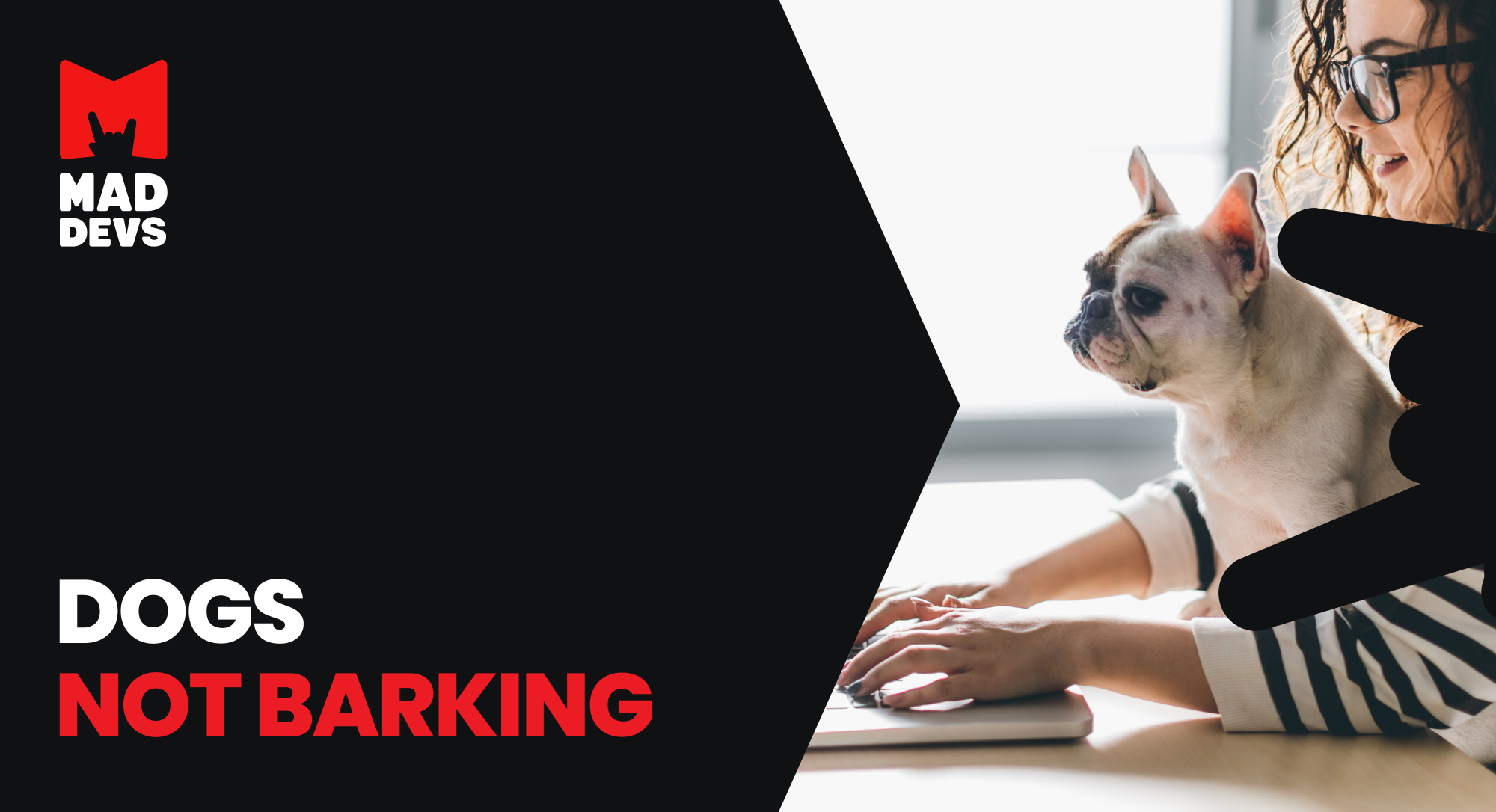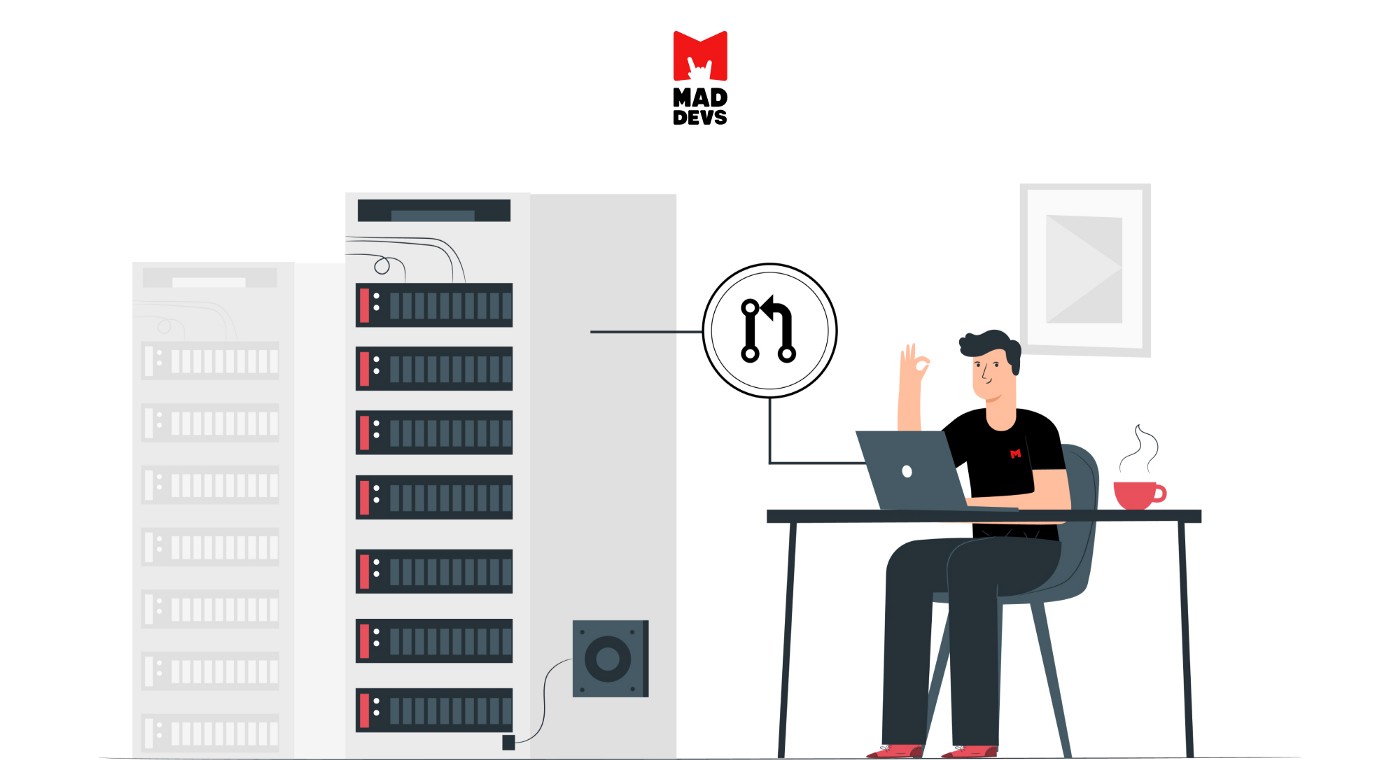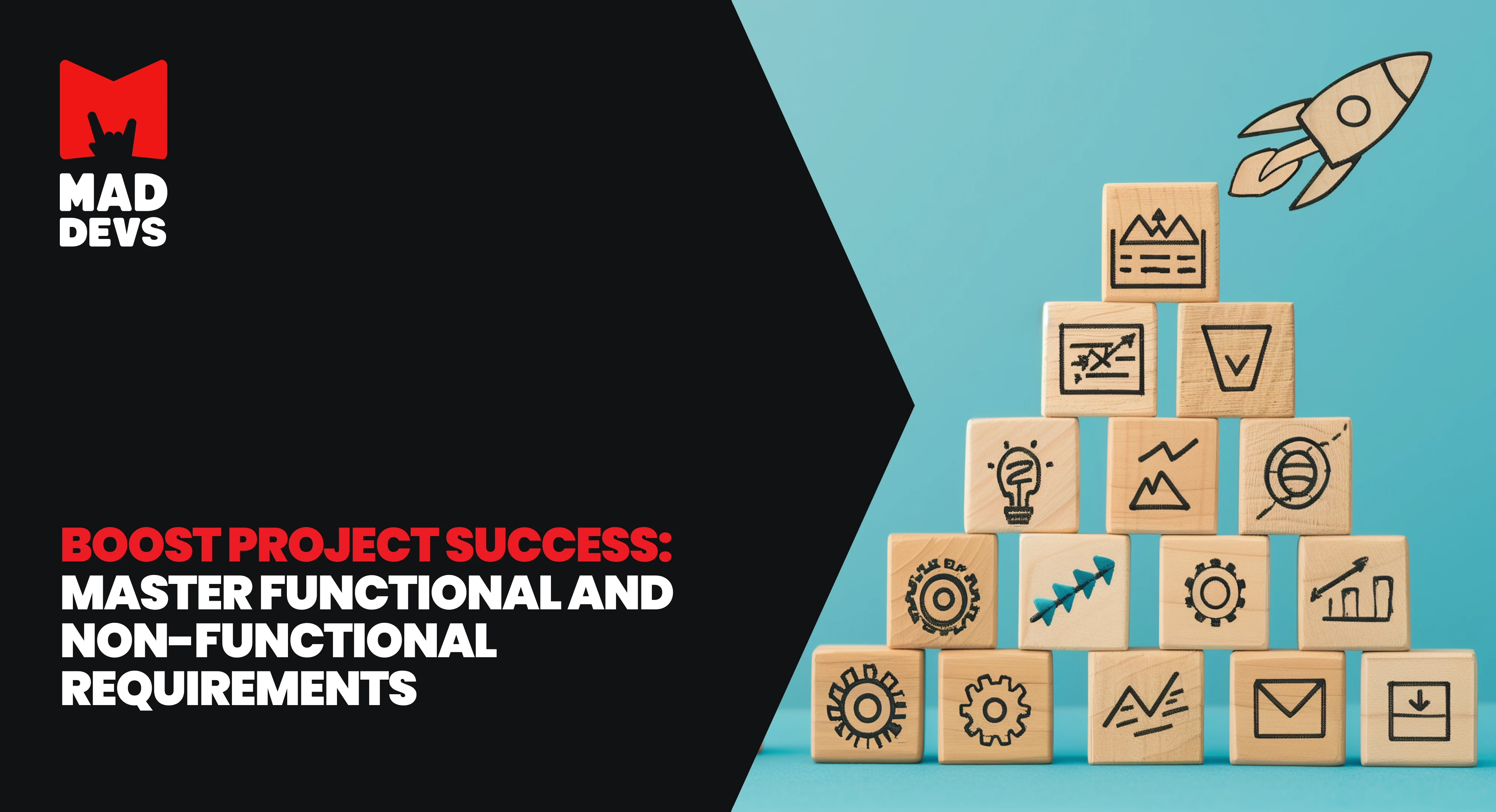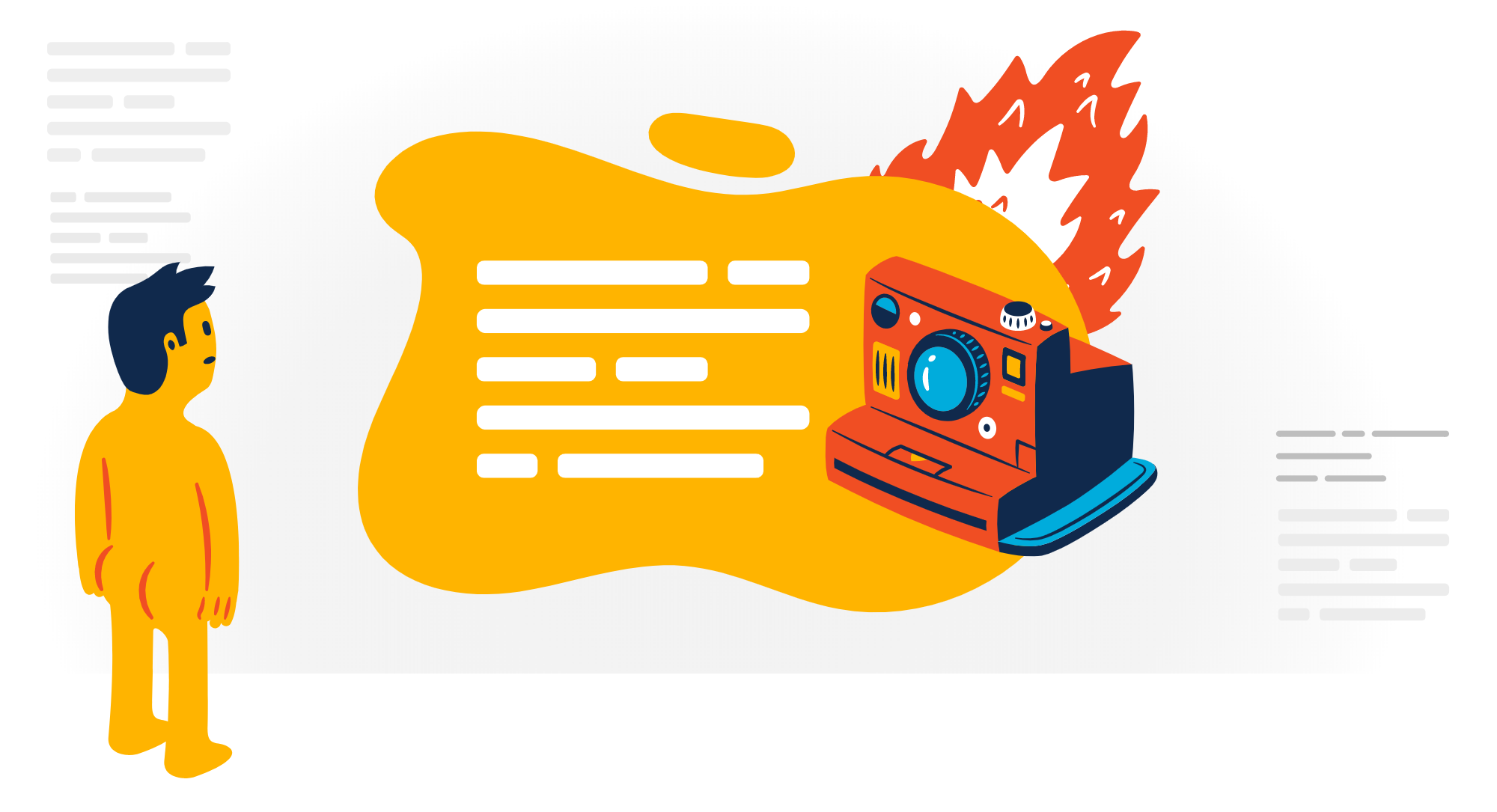The importance of documentation in software development is very easy to underestimate, but it can be a critical mistake for a project or even an entire company. However, the role of properly written and maintained documentation throughout the software development lifecycle is essential for all parties, from the company and its developers to customers and end users. It explains all the features of a project, informs us how we can work with them, helps to understand the project's functionality, and allows us to reduce onboarding time and costs.
Today we cover what software documentation is, what types there are, and why documentation is important in software development. We'll share industry best practices, approaches, and tools for documentation. Also, we will talk about single source of truth (SSOT), which is impossible without quality software documentation, but highly important to carry comprehensive information about everything that happens in a company and its projects, making this information most accessible and usable for all participants.
Single source of truth (SSOT)
Let's start with the concept of why there is so much attention paid to properly compiling and maintaining documentation and why having it can create a system that helps the entire company work much better.
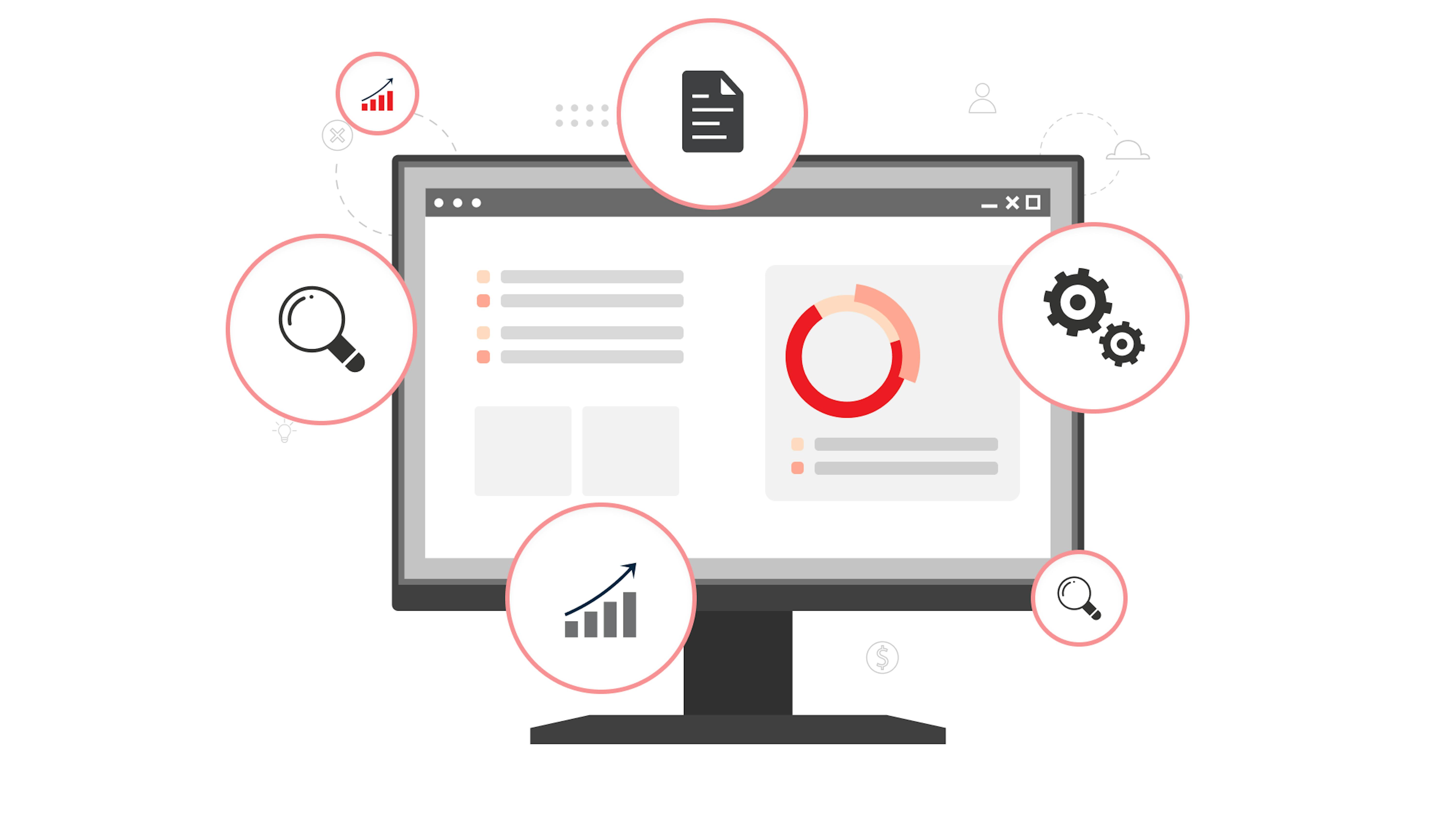
A single source of truth (SSOT) is a set of comprehensive and organized information about all projects, processes, approaches, standards, and tools of the company, which helps company members to have a universal reference point applicable to the work of all departments and any company projects.
Accordingly, without quality SDLC documentation, such SSOT will largely be very cursory and exclusively recommendatory rather than comprehensive information that gives a complete picture and a set of specific practices that bring tangible results.
What can SSOT include?
The set and order of available information in SSOT can be different from company to company because there is no single standard for it. Companies creating SSOT can include a completely different set of processes, practices, and other things. Nevertheless, let's outline the most important things which can be a part of SSoT for an IT company with high-quality SDLC documentation.
Software development documentation
It can include information from software engineering documentation, such as practices and standards for development processes, references to the resources and tools used in the development, architecture, and functionality of a particular project, contacts, and descriptions of its members, etc. Obviously, having all this information in one place and in an organized form available to everyone who needs it makes the development process much more consistent.
Regulatory compliance
Also, it can include information about the passing of external audits, negotiations with customers, or any other interactions that need to be fixed. When all the records, references, and reports about it are stored in one place, it is much easier to follow it, and it is much easier to come back to it and use it for further communication.
Centralized data repository with search engine
Of course, in addition to carefully selected and organized information, a quality search engine should allow you to do this by titles, members, tags, and all other markers, which help you find the necessary information quickly. In this case, your SSOT becomes not only infinitely valuable for work but also highly usable.
For example, we at Mad Devs build our SSOT from the company's foundation, constantly adding and improving our Confluence, providing employees with everything they need for productive work and transparent communication. Also, we share the best standards, proven practices, and advanced tools with the world in our eBooks to help anyone who wants to improve their product, company, or an entire industry.
Why is SDLC documentation important?
The software development lifecycle (SDLC) documentation is a constantly updated set of documents accompanying the project and describing everything that this project is and what happens during its development.
SDLC documentation serves as the roadmap for your software development journey, offering a multitude of benefits:
Knowledge transfer and preservation
- Documentation acts as a bridge between team members, ensuring everyone is on the same page.
- New team members can quickly get up to speed by referring to well-documented projects.
- Documentation provides a valuable historical record of project decisions, design choices, and implementation details.
Compliance and standards
- Many industries have specific documentation requirements to ensure compliance with regulations and standards.
- Documentation demonstrates a commitment to quality and can be used to assess project adherence to standards.
Team efficiency and collaboration
- Clear documentation enhances understanding among team members, leading to better collaboration and problem-solving.
- Documentation facilitates faster onboarding as new team members can quickly become. productive by referring to existing documentation.
- Documentation helps highlight the team's main goals and share them to each member.
Project management and maintenance
- Well-documented projects are easier to scale and maintain as the project grows.
- Documentation can highlight reusable components, saving time and effort on future projects.
- Historical documentation provides context for future decisions and helps avoid repeating past mistakes.
Increasing trust of external stakeholders
- Comprehensive documentation demonstrates a professional approach and can attract investors.
- Clear documentation can help support teams provide better assistance to customers.
- For open-source projects, documentation attracts contributors and fosters a thriving community.
But how to write documentation for a software project in the best way? Here, we need to start by discussing two main approaches to creating and maintaining documentation.
What are the best approaches for creating software documentation?
Since documentation is directly related to product development, the main approaches to documentation are based mainly on known project development approaches. Here, you should choose the approach you already use in product development to align the product and documentation work closely.
The Waterfall approach to creating software documentation
The Waterfall approach offers the clearest definition and description of all the goals, objectives, features, and, most importantly, the relevant processes in the project in advance and rarely includes later changes. This approach can be great for developing rather typical projects and helps to determine the budget and deadlines most accurately.
But software development is highly dynamic. And the more responsive the development approach is, the faster it reacts to changes in the technological or commercial market, so the more sustainable and profitable the final product is. That is why more and more companies, in most cases, choose the Agile approach to documentation and project development.
However, there are different companies for which the strictest timing and budgeting is the only appropriate option. Some companies and projects need strict planning, but not in all aspects. So there are proven approaches for all of them, and we highly recommend that you check out our article on this topic.
The Agile approach to creating software documentation
The Agile approach in software development, and documentation, in particular, does not require creating exhaustive and complete documentation at the start of the project. Instead, the Agile approach offers the creation of documentation based on iterations of project development, representing only the actual project state and points.
All this allows you to save project resources from the beginning, maintain project development flexibility, and keep the documentation most relevant.
What are the types of software documentation?
The design of software documentation may differ from company to company and from project to project. Still, it is right to divide it into two main types, specifically business process and product documentation.
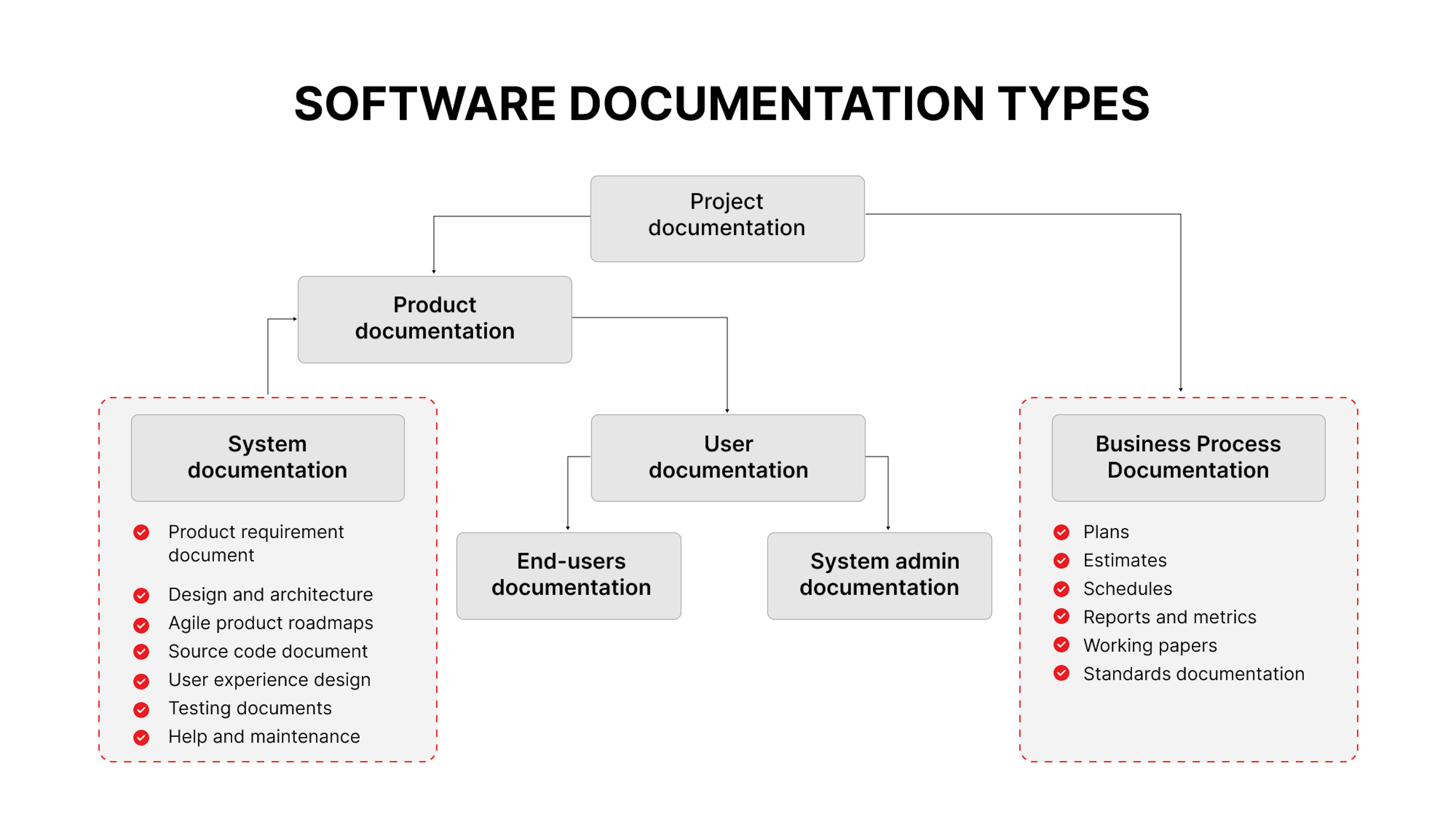
Product documentation — This focuses on the product itself, providing information on its features, functionalities, and usage. It includes:
- Requirements documents: Outlining the desired features and functionalities of the software.
- Technical specifications: Detailed descriptions of the software's architecture, components, and interfaces.
- Business logic: Explaining the underlying rules and processes that govern the software's behavior.
- User manuals: Providing instructions on how to use the software, including tutorials, troubleshooting guides, and installation instructions.
Process documentation — This describes the development process and procedures followed by the team. It includes:
- Backlogs and roadmaps: Planning and tracking project tasks and milestones.
- Coding and testing standards: Guidelines for code quality and testing practices.
- Reports and meeting notes: Documenting project progress, decisions, and discussions.
- Release checklists: Ensuring that all necessary steps are completed before a product release.
- Business correspondence: Communication related to the project, such as emails and contracts.
At Mad Devs, we use two process documentation forms, one of which helps us to present the development process in the most detailed and clear way, and the other helps to regulate development standards to ensure the best quality code.
Additionally, we use flowcharts, coding style guides, and README files to streamline collaboration and ensure code consistency across the board. Here's how each contributes to our workflow:
Mad Devs documentation best practices
By combining flowcharts, coding style guides, linters, and comprehensive README files, we ensure that every step of the development process is clear, consistent, and documented. These tools enhance code quality, reduce bugs, and make project collaboration more efficient.
Flowcharts
A Flowchart is a graphical representation of separate steps in sequential order. We use it as a program-planning tool to visualize what is going on and to help to understand the process. A flowchart might also show some flaws and bottlenecks in the process.
Flowcharts help us to:
- More clearly communicate the system's logic
- Make the debugging process easier
- Make the program analysis simpler
- Provide better documentation.
While they also have some drawbacks, for example, it isn't easy to draw a flowchart for complex processes, and flowcharts are useful when we need to visualize the process.
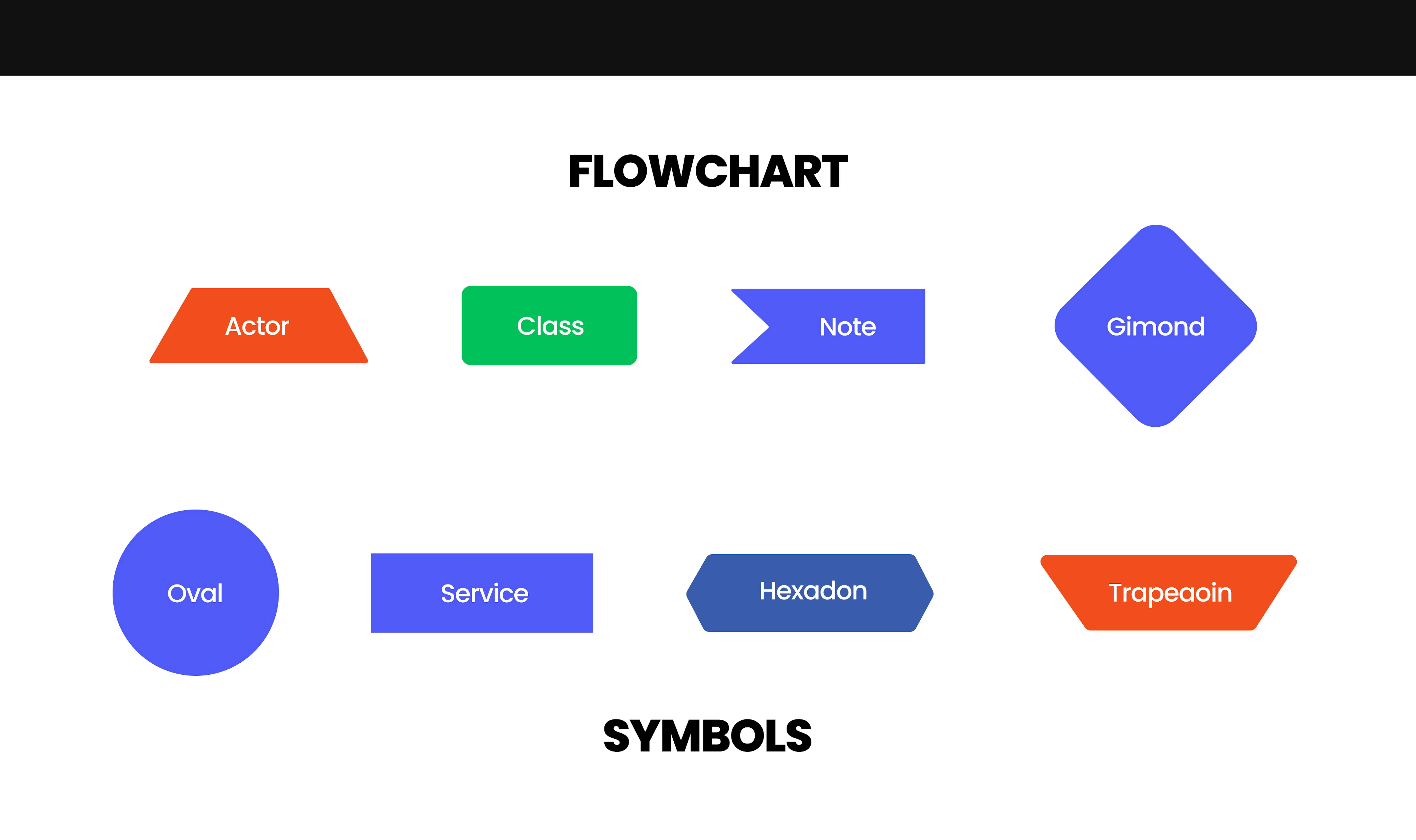
Programming style guide
We use programming style guides to ensure code uniformity. When we work on a product, the product code shall look as if it was written by one person. Even if there are many developers working on it, the code shall be uniform.
A programming style guide eliminates the need to guess about the style or, for example, how to name a variable. You simply follow predetermined rules. Coding documentation allows for more streamlined code creation and maintenance.
What do we include in a coding style guide? Whatever is related to code: indentation, vertical alignment, variable naming, comments; to eliminate any possibility of confusion, we also include such details as folder naming, asset naming, etc.
Checking hundreds or thousands of lines of code for compliance with style guides manually is difficult, if not impossible. That's why we use linters to ensure the code complies with the accepted coding style.
Linters are tools used to analyze the code for flaws, errors, stylistic errors, bugs, and suspicious constructs. Just some benefits that we get from using these tools are the following.
- Linters make code look like written by one person
We like having a project code database that looks like it was written by one person. It also simplifies code maintainability, prevents bugs, and reduces the time to market of new functionalities.
- They provide visibility of the codebase health
We use the practice of adding a step in our CI/CD pipeline to measure the code health status. As soon as your code health deteriorates, you can notice it and take measures asap.
- They increase the ownership over the code quality
Senior developers know how the code shall look and function. If there are deviations, they can propose changes to improve the code quality. However, this is not the case with inexperienced developers. Not every developer knows how to detect whether the code is of high or low quality. A linter can tell automatically when the code quality drops, and the team can make the needed changes asap. It makes the entire team take responsibility for the code.
- They help to control technical debt
There are many more advanced linters that help to control technical debt. They detect issues such as style guide mismatches, poorly designed code, or code flaws, and make technical debt explicit. For example, for Go, we use ktlink, Gofmt, and detekt to manage technical debt.
There are a lot of linters for different programming languages, software integrations, and configuration files. Any check that can be automated and that we need can be turned into a linter. We can also write our own linters even though it is not a common practice in our company because there are too many of them already. All in all, linters help us to save time, money, and productivity.
And also, in Mad Dev's we use product document README, in which we reflect in detail all the information about it
README
README is our main product document. We can compare it with a description of a product: all information about the product is presented in an understandable way. If there is no description, a developer might spend too much time trying to understand what project it is and how it shall be used.
A README document is not just a mere description though. It is a document created to help us to use the repository content without external assistance. When writing a README document, we:
- Inform the reader about the repository content.
- Create a resource that allows the onboarding of a new specialist faster and cheaper.
- Provide our client with an opportunity to check what the repository is for.
- Enable developers to start working on the project after a long break without any reverse-engineering procedures.
README components
The structure of our README documents is not fixed because the project components and resources might differ. Also, we write a README document in stages. While working on a project, we are completing its README.
For example, the How to Run Tests section can be written later when the code is covered in tests and similar. Usually, we include the following sections in a README document.
- Name – the repository name. A self-explanatory name is better. For example, if you see the name AWS-ESK Base, you aren't going to wonder what the project is about.
- Description – here, we indicate the repository content, the project (if the repository is a part of a bigger project), and why the repository resources might be useful for you. If we move on with Ansible, its description tells you everything about the repository:
- Technologies – here, we list and describe the technologies used in the repository, for example:
Apollo
Apollo Server 2.0
GraphQL - Prerequisites – in this section, we list and provide links to external resources, utilities, and modules that are required to make the repository resources function.
- Folder structure – we describe the folder structure and its content.
- How to run – it is one of the most important sections in a README document. It explains how you can work with the repository content. For example, if it is code, this section explains how to run it on your computer. Here, we mention the mode in which it can be run:
Developer mode
Testing mode
Production mode.
For Docker projects, we provide launch commands. - How to run tests – every repository contains tests, and README explains how to launch them.
- How to deploy on production – if the resources shall be deployed in production, we explain how to do it, describe how they interact with external services, and explain how to set up the environment and external services such as HTTP Proxy and similar.
- Configuration files – here, we describe all configuration files needed for the project launch.
- Variables – in this block, we describe all variables that can have an impact on the service. Then, we move on with variables. If the variables are in an environment, we start with the environment.
- Launch parameters – if there are launch parameters, we describe them, too.
- Extended documentation – if there is a landing page or extended documentation, we provide links to them.
- Mockups – here, we provide links to design mockups, sketches, a PSD file, and an interface, if any.
README formatting
What about formatting? We make it simple: we apply special formatting for:
- Code
- Console commands
- Variables description
It is worth remembering that your README doesn't sell your work. It explains how your product works, how it can be used, and what problems it solves. It shall enable developers to understand everything about your project without delving into code. Once your document complies with these requirements, we can call it successful.
4 main requirements in software documentation
Here are some essential requirements and ready solutions you can safely practice to ensure compliance with industry best practices and standards, getting the most out of them and making your documentation the highest quality.
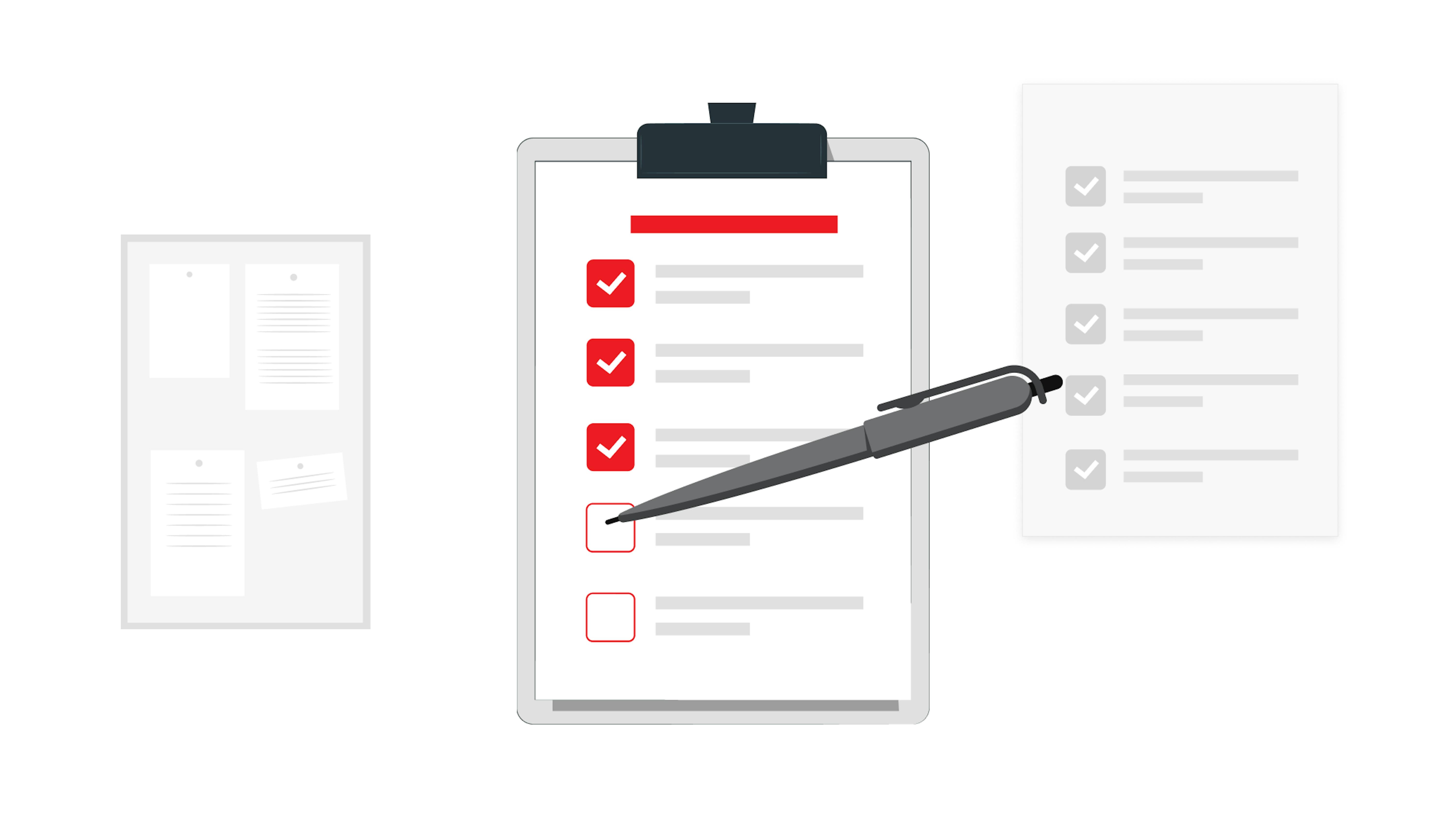
1. Write the documentation in the necessary scope and detail
There should be enough of everything. While striving to ensure that your document contains what is necessary only, you should not omit details that may be important to customers, developers, or users. At the same time, to provide each of them with comprehensive information, you need to ensure that it is not excessive and does not take more time to study than necessary.
The same applies not only to its scope but also to its form. The documentation should not use excessively complex or specific wording so that those who use it will immediately get the information they need rather than being challenged to get it. At the same time, the wording should be carefully chosen and structured to capture the subject matter most accurately.
2. Use graphics and links
Information provided in a visual format is much faster and better understood by most people. If the type of document, item, or process allows you to capture it graphically, you can present it in a way that is much more meaningful and understandable to anyone reading the documentation, regardless of their technical or business background.
Also, use hyperlinks to provide the ability to quickly find the information needed for further study without having to go beyond the documentation. This way, the documentation reader is not interrupted while studying it, and it is much quicker and easier to get the information they need.
3. Documentation is a team effort
Documentation includes the work of very different departments, from developers and designers to analysts and marketers. If a person who works in only one of them is going to collect and write out the work results, most likely, the documentation will not include everything you need in a proper form.
Therefore, all documentation units should come from those directly involved in a particular part of the product. Then the documentation will provide the most complete and accurate information in every aspect.
And also, a technical writer with good technical knowledge and word processing skills is needed to make the final documentation not only comprehensive but also the easiest to learn and use.
4. Documentation should be up-to-date
Documentation should keep pace with the processes or products and always represent their most actual current state. If this is not done, such documentation simply loses its meaning and does not help speed up the development process, simplify the work with the product, etc.
In order to keep the documentation up-to-date, its updating needs to be the same task as the development of the product itself and needs to take place on schedule. You can also use version control for the documentation, as for the product itself, to greatly simplify its management and creation.
Red flags of poor software documentation
To ensure the quality of your software documentation, watch for these red flags that indicate potential issues:
- The documentation does not have a separate repository or any other tool or platform properly structured and accessible to all project participants.
- The documentation does not have a separate regular task in the project management system, with clearly defined responsibilities and strictly defined regular deadlines.
- There are no clear standards for documentation, quality assessment points, and actuality checks.
- The documentation is maintained by only a few team members instead of each direct participant.
- If you do not have a technical writer, the documentation remains difficult for everyone who needs it.
Considering these challenges, it's crucial to adopt robust strategies to ensure your documentation remains clear, consistent, and valuable. Now, summarizing all the above, we can explore how to properly maintain software documentation to overcome these issues and support your team effectively.
How to properly maintain software documentation?
Maintaining high-quality software documentation is crucial to keeping projects on track and ensuring seamless team collaboration. Here are key strategies to ensure your documentation remains effective:
1. Establish a documentation process
- Clearly outline who is responsible for creating, updating, and maintaining different types of documentation.
- Establish consistent templates, formats, and style conventions to ensure uniformity.
- Conduct periodic reviews to assess the accuracy and relevance of existing documentation.
2. Continuous updates
- Update documentation as code changes — Whenever modifications are made to the codebase, ensure that corresponding changes are reflected in the documentation.
- Store documentation files in a version control system (like Git) to track changes and revert to previous versions if necessary.
- Provide detailed explanations for major updates or feature additions.
3. Clear and concise writing
- Avoid technical jargon that may be unfamiliar to less experienced team members.
- Structure documentation in a way that is easy to understand and navigate.
- Provide examples and illustrations. Use diagrams, code snippets, and screenshots to clarify complex concepts.
4. Leverage documentation tools
- Select a documentation tool that suits your team's needs and preferences.
- Integrate your documentation tool with your development environment to streamline the process of creating and updating documentation.
- Create reusable templates and macros to speed up documentation creation.
5. Encourage team involvement
- Foster a culture where everyone contributes to maintaining accurate and up-to-date documentation.
- Actively seek feedback from team members and make necessary adjustments based on their input.
6. Consider automated documentation
- Explore tools that can automatically generate documentation based on code comments or annotations.
- Assess whether automated documentation can complement your existing process and improve efficiency.
How to choose a software documentation tool?
The choice of a software documentation tool depends largely on what tools a company already uses, what kind of integration options they provide, and how extensive its documentation capabilities are. Here, we list the top tools, many of which we successfully use ourselves.
Atlassian Confluence — A powerful collaboration platform offering project management, team communication, and knowledge base creation tools.

➕ Pros
- Integrates with Jira and other Atlassian tools for seamless project management.
- Offers a flexible wiki system for creating interconnected documents.
- Supports user story management within documentation.
➖ Cons
- Can have a steeper learning curve for new users compared to simpler tools.
- Expensive for smaller teams compared to some competitors.
- May feel overwhelming for simple documentation needs
Document 360 — A dedicated platform specifically designed for building and managing comprehensive software development knowledge bases.

➕ Pros
- Focused platform specifically for knowledge base creation
- Extensive options for managing and maintaining documentation
- Strong features for software development documentation
➖ Cons
- May not be ideal for collaborative documentation with multiple teams
- Might not integrate with other project management tools you use
- Can be a separate platform to learn and manage
Bit.ai — A collaborative document creation tool that focuses on real-time co-editing, interactive elements, and easy code integration.

➕ Pros
- Collaborative and interactive features for document creation
- Ability to embed code directly and link to other documents
- Offers PDF export for easy sharing
➖ Cons
- Primarily focused on collaborative documents, not traditional knowledge base
- Might not be suitable for large-scale, structured documentation
- May not integrate with your existing project management tools
GitHub / GitLab — Version control systems (VCS) that also offer document hosting features, allowing version control, internal linking, and wiki-style documentation creation.

➕ Pros
- Free and widely used option
- Integrates well with existing coding projects
- Offers wiki system for linking documents and code
- Version control for documentation changes
➖ Cons
- Documentation may not be as user-friendly or visually appealing
- Limited tools for collaborative editing and formatting
- Difficult to share documentation publicly without additional setup
Bottom line
As you can see, documentation is not limited to reports only. We create documentation at all stages of the development process. It helps us to write code consistently, ensure code quality, and make the entire process more understandable.
If you need expert guidance on optimizing your documentation strategy, we're here to help. Contact Mad Devs for a free consultation and discover how we can support your documentation needs to streamline your development process and boost your project's efficiency.

